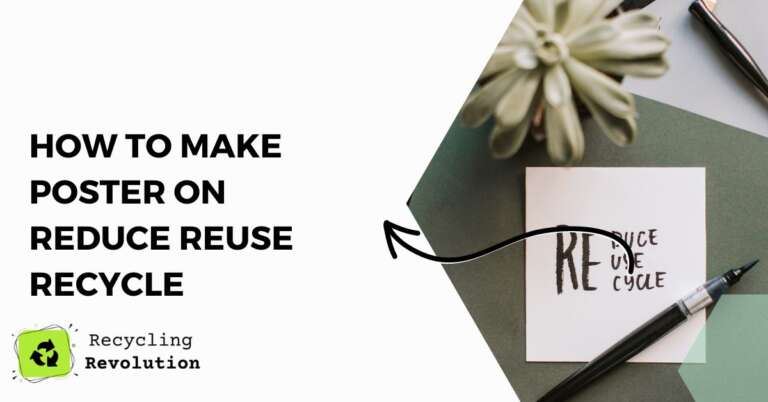The most important element is ensuring the message of reduction, reuse, and recycling comes through clearly, engagingly, and action-inspiringly.
TL;DR: Creating a compelling poster on ‘Reduce, Reuse, Recycle’ involves strategizing on message delivery, designing with impact, and employing creativity. You start by identifying your target audience and crafting a clear, concise message.
Unleashing Your Creativity for a Greener Future
Raising awareness around sustainable living, I recommend starting any creative project with an in-depth understanding of your audience and message.
Your poster’s primary purpose is to promote the concepts of reducing waste, reusing items, and recycling materials, but your approach to this message will vary depending on your audience.
For a younger demographic, you might opt for colorful, cartoon-like visuals and simple, catchy phrases. On the other hand, an adult audience may respond better to stark, impactful imagery and detailed, thought-provoking facts about waste and sustainability. It’s all about tailoring your content to resonate with your viewers and spark change.
Plotting Your Message Delivery
Crafting a powerful message is crucial to any effective Reduce, Reuse, Recycle poster. This message should be clear, concise, and easily understandable.
Start by brainstorming key points you want to address. Some possibilities might include:
- The problem of waste and pollution.
- The importance of reducing consumption.
- The benefits of reusing items.
- How to recycle properly.
- The impact individual actions can have on the environment.
Once you have your points, condense them into a powerful, succinct statement or question that grabs the viewer’s attention and encourages them to read more. For instance, “What if the solution to pollution was in your trash?” or “Reduce. Reuse. Recycle. Our planet deserves it.”
Designing with Impact
Having an impactful design is essential to your poster’s success. Your visuals should tell a story and reinforce your message. Here are some aspects to consider:
- Layout: Use the rule of thirds or golden ratio to structure your poster. Place your most critical elements – your main message and central image – along these lines to draw the viewer’s eye.
- Color: Choose colors that support your message. Greens and blues often represent nature and tranquility, while yellows and reds can signify urgency or caution. Make sure there is enough contrast between your background and text to ensure readability.
- Typography: Choose clear, legible fonts. The font style should also align with the poster’s theme. For instance, a playful, rounded font might be perfect for a children’s campaign, while a clean, sleek font might better suit an office setting.
- Imagery: Use impactful visuals to reinforce your message. This could be photos, illustrations, infographics, or even creative use of text. Ensure the images used are of high quality and fit well within your layout.
Calling for Action
Every effective Reduce, Reuse, Recycle poster includes a clear call-to-action (CTA). This instructs the viewer on what steps to take after they’ve absorbed your message.
It could be as simple as “Recycle your plastics here” or more comprehensive, like “Start your journey to sustainable living today.”
Ensure your CTA is prominently positioned and in a larger, bolder font to make it stand out. The CTA’s goal is to inspire individuals to change their behaviors and contribute to a more sustainable world.
Emphasizing the Message: Reduce, Reuse, Recycle
Remember, your poster’s primary goal is to drive behavioral change and promote sustainability. To achieve this, every element of your poster should serve to reinforce and spotlight your central message.
Note: I suggest spending some time refining your central message, ensuring it’s impactful, concise, and memorable. You might consider popular slogans like “Every little bit counts!” or “Make waste useful again!” or even create your own unique tagline that will resonate with your audience.
The Power of Symbolism
Using symbols can significantly enhance the effectiveness of your poster. Symbols can communicate complex messages quickly and memorably.
For example, a simple image of a recycling bin, a light bulb, or a tree can immediately convey specific aspects of your message. The recycling symbol – three arrows forming a continuous loop – is a universally recognized icon that you can incorporate into your design.
Also, consider the use of less conventional symbols that may offer a fresh perspective on the theme of reducing, reusing, and recycling.
Storytelling through Design
An essential aspect often overlooked in poster design is the power of storytelling. Through the careful placement of elements and the choice of imagery and color, your poster can take the viewer on a journey.
You can consider a story that illustrates the process of ‘Reduce, Reuse, Recycle.’ For example, the story could start with the problem – pollution or waste, move on to the action – reducing, reusing, recycling, and end with the result – a cleaner, healthier planet.
Making it Interactive
A unique way to engage your audience is by making your poster interactive. This could be by incorporating elements like QR codes that link to informative websites or videos about the benefits of reducing, reusing, and recycling.
Or you could create a part of the poster where people can pledge to live more sustainably and sign their names.
Remember, the goal of your poster is not just to inform, but also to engage and motivate action towards more sustainable behaviors. By making your poster interactive, you encourage active participation and foster a deeper connection with your message.
The Importance of Feedback
I can’t stress enough the importance of getting feedback on your poster. Feedback provides valuable insights that can help you improve your design and messaging.
Encourage people from your target audience to critique your poster, focusing on aspects like readability, visual appeal, clarity of message, and the effectiveness of your call-to-action. Use their feedback constructively to refine and perfect your poster.
Design Iteration and Improvement
Don’t be discouraged if your first draft doesn’t turn out perfect. The best designs often come from iteration and improvement. Use each version as a learning opportunity to better understand what works and what doesn’t.
Experiment with different layouts, colors, typography, and imagery until you find the perfect balance that conveys your message powerfully and effectively.
Remember, creating a Reduce, Reuse, Recycle poster is not just about aesthetic appeal; it’s about communicating an important message in the most impactful way possible.
Therefore, take your time, consider each element carefully, and strive to make your poster a compelling call to action for a more sustainable future.
Reduce, Reuse, Recycle Poster – Your Blueprint to Success
| Step | Action |
|---|---|
| 1 | Identify your target audience |
| 2 | Craft a clear, powerful message |
| 3 | Plan your layout |
| 4 | Choose appropriate colors |
| 5 | Select legible and thematic fonts |
| 6 | Incorporate impactful imagery |
| 7 | Include a strong call-to-action |
Additional Tips and Tricks
While the fundamentals of poster design are important, don’t forget to let your creativity shine. Experiment with different designs, seek inspiration from others, and always be open to feedback.
Here are a few extra tips to take your Reduce, Reuse, Recycle poster to the next level:
- Use a mix of text sizes and weights to create a visual hierarchy.
- Don’t overcrowd your poster. Negative space can make it easier for the viewer to absorb your message.
- Consider your poster’s placement. Where will it be displayed? What size constraints might you have?
Note: It’s crucial to stay accurate and respectful when dealing with sustainability issues. Ensure your information is up-to-date and sourced from reliable outlets.
Conclusion
To make a good poster about reducing, reusing, and recycling, think about who will see it and make your message clear and strong. Use bright colors and big pictures for kids or serious images and facts for adults.
Your poster should look good and show your message well, using the right colors and layout. Make sure to tell people what to do, like “Recycle here.” Your poster should make people want to take care of our planet. Get advice and keep improving your poster. Your goal is to create something that not only looks good but also encourages people to help the environment.
FAQs
Can I make a Reduce, Reuse, Recycle poster digitally?
Absolutely! There are several digital tools available, like Canva, Adobe Illustrator, or even Microsoft PowerPoint, which can help you design a poster.
How can I print my poster sustainably?
Try to use recycled or sustainably sourced paper. You can also consider using a local printing service to reduce carbon emissions associated with shipping.
What should I do with my poster after its use?
Try to repurpose it, or make sure to recycle it properly. If your poster has sparked conversations and influenced behaviors, it’s already made a significant impact.

